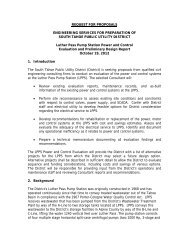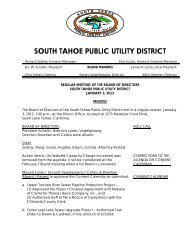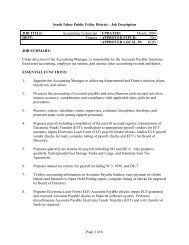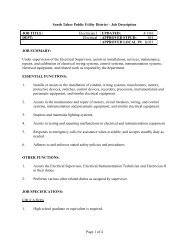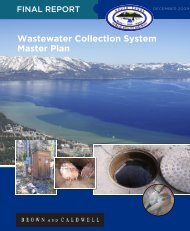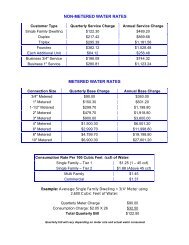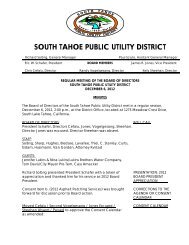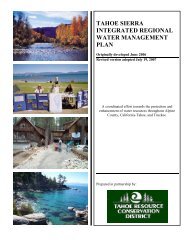October 2009 - South Tahoe Public Utility District
October 2009 - South Tahoe Public Utility District
October 2009 - South Tahoe Public Utility District
You also want an ePaper? Increase the reach of your titles
YUMPU automatically turns print PDFs into web optimized ePapers that Google loves.
The Master Plan projects include three classifications, namely recommended projects,<br />
contingent projects and future projects as described in Section 8.<br />
A Decision Tree presented in Figure 13.1 (at the end of Section 13) lists project implementation<br />
considerations based on various triggers to compensate for increased recycled water<br />
production, changes in available application areas for recycled water, or changes in application<br />
rates resulting from application technology or regulations. There are three trigger mechanisms<br />
discussed in greater detail in the following subsections.<br />
This section also includes a capital improvement plan for construing the recycled water<br />
infrastructure projects, and a description of the future projects identified in the Master Plan.<br />
Lastly, a list of summary recommendations is provided.<br />
13.1 Development Triggered Project Implementation<br />
Development triggered project implementation includes projects that result in additional lands<br />
being used as application areas as well as application of technology projects that increase the<br />
amount of water consumed on an acre-feet per acre basis. The latter project type includes high<br />
water consuming projects, where the increased application areas include the use of the<br />
Diamond Valley property, expansion of Alpine County agricultural lands, and export of excess<br />
recycled water to Nevada.<br />
The potential for loss of application areas in Alpine County is difficult to assess. With the proper<br />
incentive for contract irrigators to use the recycled water and maintain existing ranching<br />
practices, it is possible to lose very little of the existing application areas. However, with the<br />
trend of large ranches being fragmented into smaller, less efficient ranches, and the prospect of<br />
ranches being more valuable as semi-rural home sites, the potential for the development of the<br />
application areas exists.<br />
The Decision Tree, Figure 13.1 (at the end of Section 13), indicates several directions for<br />
development triggered project implementation. The first and easiest to implement is the<br />
expansion of recycled water application in Diamond Valley, including the recycled water<br />
required to support the irrigation fields. An acre of application area lost from the system results<br />
in an approximately 3.25 acre-feet annual additional direct land application requirement that<br />
needs to be developed in the system. The 3.25 acre-feet per year direct land application rate is<br />
an assumed rate used for planning purposes in this Master Plan and can be verified through the<br />
preparation of Nutrient Management Plans. For comparison purposes Table 13.2, (page 13-93)<br />
Annual Flow and Application Acreage Data, develops values using a range of other possible<br />
application rates.<br />
<strong>South</strong> <strong>Tahoe</strong> <strong>Public</strong> <strong>Utility</strong> <strong>District</strong><br />
Recycled Water Facilities Master Plan - <strong>October</strong> <strong>2009</strong> Page 13-90



